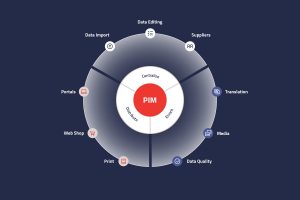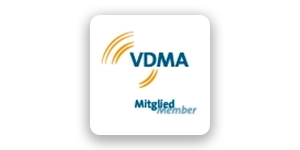Product Information Management
Indispensable PIM Functions You Should Know About

Content
These PIM Functions Optimize Your Product Management
A Product Information Management system, in short PIM, supports you in digitalizing your product processes and boosting your competitive strength. This sounds promising, but how exactly do you put things into practice?
On the markets, there is a vast selection of the most diverse PIM systems with a great variety of specialization areas. What functions, however, are required to which end? Which functions are necessary to support you in elevating your Product Communication to the next level? We want to get at the bottom of these questions in this blogpost. Though, before we commit to an in-depth analysis of elementary PIM functions, let us, first of all, give a clear answer to a foundational question: What is PIM and what can it do?
Definition: What is PIM?
Product Information Management encompasses the complete administration of all product data and information of a company. As far as technology is concerned, Product Information Management is realized via a software system. PIM functions as the central data pool and is connected to multiple source systems (CMS, ERP, CRM). A PIM can map all of your product data processes: collect, manage, enrich, and distribute data into various marketing and sales channels. You want to know all the nitty-gritty details about PIM? We’ve got you covered with our blogpost “What is PIM?”, providing you with all relevant information you need to get yourself started.
You can imagine PIM software like an all-in-one platform for all your products and product data – your datahub. Product data and information from various data sources is pooled and stored centrally, allowing you to serve all possible kinds of agents and relevant target channels: online shops, social media channels, print catalogs, digital product catalogs, or suppliers and resellers. You can establish order at the click of a button and always keep the overview in the “data jungle.”
A PIM software consists of multiple software components which respond to the various requirements you have for your system. The software lifts the heavy weight for many agents – it’s the allrounder for your product data.
When is PIM useful?
Many companies run an ERP system such as Navision or SAP for their internal production process. Furthermore, there are many outlets relevant to your Product Marketing such as a diverse range of web platforms and different print media which all require product data.
Historically, we’ve observed that companies without a PIM system firmly embedded into their software infrastructure suffer, more often than not, from inefficient processes when it comes to creating and refining data required for Print and Web. For historical reasons, in fact, companies usually conceive of Print and Web as two entirely different processes altogether. Accordingly, it used to be tedious manual labor to integrate product data already pooled in the Enterprise Resource Planning system into both of these split processes.
In order to bridge the gap between all systems and sources, while also boosting the efficiency of daily work revolving around this area of functionality, PIM systems are equipped out-of-the-box with various special features. These features are what we want to have a look at right now in the following chapters.
Requirements to Data Storage
The data storage of product information and additional meta-data for Marketing processes in the fields of Print and Web form the foundation of a PIM software. This comes with a range of functions and requirements for data organization and data maintenance. Concerning this elementary aspect, let’s dig a bit deeper into the material and have a closer look at how things roll:
Mapping Complex Product Data Structures
In order for all data storage requirements to be fully satisfied, complex data structures must be represented within the system. This includes:
- Organizing various object types such as product groups, products, articles, company departments, and sales structures
- Hierarchical product structures
- Cross-references between articles, such as “spare parts” or “synergizes with”
- Mapping to different hierarchical structures from various source and target systems
No Redundant Data Management
Since product data supplies, in most use cases, multiple distribution channels with the same content, data should only be compiled, edited, and validated once – in particular including otherwise costly translation processes. Yet, some attention to detail is required here: ‘same’ doesn’t always mean ‘same.’ There are a great many exceptions to the rule. For example, a product description for Web can be more extensive than on print catalog pages with limited physical space. In order to work efficiently, you need to be able to master such exceptions in a timely manner. With a PIM, it’s a piece of cake to define and implement any possible exception to the rule. All requirements are supported by corresponding PIM functionality to reference data for a given use case.
Support for Complex Data Formats
Product data records are more than simple aggregates of short texts combined with some numerical values; you also need to be able to handle more complex data formats. Here, the essential formats are:
- Mark-up text
- From–to value range fields
- Date attributes in user-definable formats
- Pre-defined selection fields
- Hierarchical and/or multivalent selection fields
- Tables and multi-dimensional pivot tables
- Fields for managing media such as images and PDF documents
In-Depth Search Functions
Once the central data storage is secured, users wish for an effective option for finding relevant data more conveniently. Here, too, PIM supports you with the following functions:
- Full-text search
- Definable data search scope
- Search criteria for finding specific data objects or records, e.g. “find all articles which have been edited within the last week” to export them, or “find all products which use the spare part ‘X4711’.”
Built-In Workflow Support
To facilitate daily data creation and management, there are many PIM functions for controlling workflows. This allows for parallel data editing and collaboration between multiple users. Always keep a clear overview of the “data jungle.”
Support for Translation Processes
In order to market products internationally, the translation of product data and information is always important. Besides efficient data management, a PIM software also ought to optimally map the translation process. Ideally, all of the following points can be accounted for:
- Functions for the on-boarding of third-party translation agencies
- User-defined translation tasks for a specific set of data in selected languages depending on the given use case
- Transparent overview of current translation state for all data records in your system
- Automatic labeling of text data in the system: Which of the texts being displayed are translated or untranslated, have changes been made to a text which require new translations?
Media Management
Again, product data is so much richer than plain text and numerical values. It also encompasses: images, videos, documents, datasheets, technical drawings, and much more. These different formats and objects must also be managed appropriately using PIM functions. And here, too, you require extensive search functionalities and, perhaps more importantly, a direct, bi-directional connection between these media assets and products. This is because users usually don’t search for a specific image but the corresponding article – which is also linked to all other relevant images and documents for further context. If such PIM functions are provided, users always find what they are looking for first try, instead of having to commit to a tedious search procedure.
Publishing Generation
The generation of publications and print products can be quite resource heavy and time consuming. Be it catalog, flyer, or datasheet – different publications come with different requirements. In order to make all processes revolving around publishing run more smoothly, a PIM is to support both semi-automated and fully-automated page generation for various formats. Additionally, a direct export for both DTP systems, such as InDesign or Quark, as well as PDF documents should be supported. The following points are relevant to this end:
- Live preview of generated pages
- Editing document pages within the system; this way, not every user requires a full DTP setup
- Update document pages with new content from the PIM system, e.g. for updating prices
- Generate pages with multi-lingual data
- Layering of content in DTP documents, allowing you to disable different units of content and/or content in different languages on demand
- DTP plugins which allow you to access data directly from the DTP document and even transfer changes made to data back to the system
The Perfect Symbiosis between All Systems
As the central data storage system, PIM requires connectivity to other systems, such as the Enterprise Resource Planning system or web shops. In turn, there may also be external systems which require direct access to product or marketing data.
Here, we differentiate between two types of interfaces: file-based interfaces and application programming interfaces (API). In the former case, systems exchange data by sending and receiving files. In the latter case, the systems communicate directly with one another.
The typical data formats for file interfaces are csv, xml, and json. A PIM should allow you to set up both import and export interfaces for these file formats via a built-in configurator. For more exotic, industry-specific file formats, some individualization and programming may be required.
For the data transfer from program-to-program, there are three options:
1. The external program communicates with the Rest services of the PIM system, allowing for reading and writing data in the PIM system.
2. So-called middleware can be used as a mediator between the to-be-connected systems (e.g. the mediator communicates with the provide Rest services) to transfer data. Such software allows you to realize more complex data transformations and processing logics.
3. The PIM system realizes the interface for the external system using embedded individual software (i.e. scripts) which can, in turn, communicate with the external system using Rest requests or other mechanisms.
In fact, PIM systems with a good and fast interface configurator are even utilized by some companies as a middleware for connecting all their input systems with relevant output systems.
Mods for Custom Functions
Eventually, there will always be a situation where a minor use case comes up which requires some specific adjustments to the application and which is, as such, not directly included in the PIM system out-of-the-box. A PIM system should be extensible and feature the technology necessary to integrate such requirements upon request:
- Communicating with Rest interfaces of external software for data exchange
- Industry-specific calculation logic for product properties
- Automated multi-line text generation based on technical data using a customized rule set
Ideally, this is realized using custom scripts which can be implemented using out-of-the-box functionalities. In the case of eggheads Suite, such extensions based on your requirements pose no problem whatsoever.
Getting the Best out of Things with PIM – From Efficiency to Optimized Customer Experience
Equipped with the right functions, the implementation of a Product Information Management system offers a great many benefits to your company:
- Efficient processes and workflows
- Significantly shorter time-to-market
- Improved data quality via centralization of all product data
- Enabling multi-channel and omni-channel strategies thanks to consistent, up-to-date, and channel-specific product information
- Saving time and resources when automating print publications
- Optimization of product descriptions
- Your product presented in the best possible light to your customer
💡
A PIM supplies you with the optimal basis for facilitating your and your coworker’s data management tasks, rendering corporate processes more efficient. With that, you finally have all the time you need at your hands for focusing on the important matters: designing unique Product Experiences for your users and improving Customer Experience.
From Our Blog
You may also be interested in the following articles








